Press Releases 2013
Where Will Debris from Super Typhoon Haiyan Go in the Ocean?
Honolulu, November 22, 2013
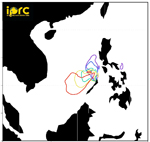 Using the model developed for the 2011 tsunami debris, IPRC’s Nikolai Maximenko and Jan Hafner are projecting paths for the debris that might have been generated by super typhoon Haiyan in the Philippines. According to the model, any typhoon-generated marine debris is expected to move westward through the Philippine Archipelago into the South China Sea. Unclear is whether from there it would be carried to the coasts of Vietnam or would be diverted by currents and winds to different shores of the South China Sea. Read press release.
Using the model developed for the 2011 tsunami debris, IPRC’s Nikolai Maximenko and Jan Hafner are projecting paths for the debris that might have been generated by super typhoon Haiyan in the Philippines. According to the model, any typhoon-generated marine debris is expected to move westward through the Philippine Archipelago into the South China Sea. Unclear is whether from there it would be carried to the coasts of Vietnam or would be diverted by currents and winds to different shores of the South China Sea. Read press release.
El Niño Is Becoming More Active
Honolulu, October 28, 2013
 A new approach to analyzing paleo-climate reconstructions of the El Niño Southern Oscillation (ENSO) phenomenon resolves disagreements and reveals that ENSO activity during the 20th century has been unusually high compared to the past 600 years. The study, published in Climate of the Past, was co-authored by IPRC's Axel Timmermann and by Shayne McGregor and colleagues at the University of New South Wales and at the NOAA Geophysical Fluid Dynamics Laboratory.Read press release.
A new approach to analyzing paleo-climate reconstructions of the El Niño Southern Oscillation (ENSO) phenomenon resolves disagreements and reveals that ENSO activity during the 20th century has been unusually high compared to the past 600 years. The study, published in Climate of the Past, was co-authored by IPRC's Axel Timmermann and by Shayne McGregor and colleagues at the University of New South Wales and at the NOAA Geophysical Fluid Dynamics Laboratory.Read press release.
Honolulu, July 1, 2013
Reliable prediction of El Niño response to global warming is difficult, as El Niño varies naturally over decades and centuries. Instrumental records are too short to determine whether recent changes are natural or attributable to increased greenhouse gases. An international team of scientists, spearheaded by Jinbao Li and Shang-ping Xie while at the IPRC, now shows that recent El Niño activity is the highest for the past 700 years, possibly a response to global warming. The work is published in the June 30, 2013, online issue of Nature Climate Change. Read press release.
Climate researchers find new rhythm for El Niño
Honolulu, May 26, 2013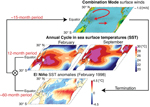 Why El Niño peaks in boreal winter and ends quickly in February to April has been a long-standing mystery. The answer lies in an interaction between El Niño and the annual cycle that generates an unusual wind pattern in the tropical Pacific with a 15-month period, according to a study by IPRC's Axel Timmermann and Malte Stuecker and Fei-Fei Jin at the UH Manoa Meteorology Department. The study that may lead to improved El Niño Forecasting was published in the May 26 online issue of Nature Geoscience. Read press release.
Why El Niño peaks in boreal winter and ends quickly in February to April has been a long-standing mystery. The answer lies in an interaction between El Niño and the annual cycle that generates an unusual wind pattern in the tropical Pacific with a 15-month period, according to a study by IPRC's Axel Timmermann and Malte Stuecker and Fei-Fei Jin at the UH Manoa Meteorology Department. The study that may lead to improved El Niño Forecasting was published in the May 26 online issue of Nature Geoscience. Read press release.
The Tropical Upper Atmosphere “Fingerprint” of Global Warming
Honolulu, May 23, 2013
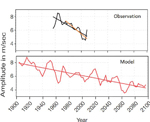 The winds of the quasibiennial oscillation in the tropical upper atmosphere have greatly weakened at some altitudes over the last six decades, according to a study by IPRC’s Kevin Hamilton and JAMSTEC’s Yoshio Kawatani. The finding, published in the May 23, 2013, issue of Nature, is consistent with computer model projections of how the upper atmosphere responds to global warming induced by increased greenhouse gas concentrations. Read IPRC press release; read JAMSTEC press release; and read article.
The winds of the quasibiennial oscillation in the tropical upper atmosphere have greatly weakened at some altitudes over the last six decades, according to a study by IPRC’s Kevin Hamilton and JAMSTEC’s Yoshio Kawatani. The finding, published in the May 23, 2013, issue of Nature, is consistent with computer model projections of how the upper atmosphere responds to global warming induced by increased greenhouse gas concentrations. Read IPRC press release; read JAMSTEC press release; and read article.
Sea level impact on Indo-Pacific climate during glacial times
Honolulu, May 19, 2013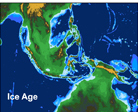 Pedro DiNezio of the International Pacific Research Center, University of Hawaii at Manoa, and Jessica Tierney, Woods Hole Oceanographic Institution, investigated preserved geological clues (called “proxies”) of rainfall patterns during the last ice age when the planet was dramatically colder than today. Comparing these patterns with computer model simulations, they found that the exposed Sunda Shelf during the last ice age shifted rainfall and convection westward.
Read press release.
Pedro DiNezio of the International Pacific Research Center, University of Hawaii at Manoa, and Jessica Tierney, Woods Hole Oceanographic Institution, investigated preserved geological clues (called “proxies”) of rainfall patterns during the last ice age when the planet was dramatically colder than today. Comparing these patterns with computer model simulations, they found that the exposed Sunda Shelf during the last ice age shifted rainfall and convection westward.
Read press release.
More Hurricanes for Hawaii?
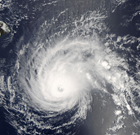
Honolulu, May 5, 2013
Hawaii, fortunately, has been largely free of hurricanes in the recent past, only two having made landfall in more than 30 years.
Now a study headed by IPRC's Hiroyuki Murakami shows that more tropical cyclones may come close to Hawaii by the last quarter of this century. The study appears in the May 5, 2013, online issue of Nature Climate Change. Read press release.
Less rainfall expected for the Hawaiian Islands
Honolulu, April 23, 2013
 Almost imperceptibly, rainfall over the Hawaiian Islands has been declining since 1978, and this trend is likely to continue with global warming through the end of this century, according to a team of scientists by IPRC's Oliver Elison Timm and colleagues at the University of Hawaii at Manoa (UHM) and the University of Colorado at Boulder. The study appeared in the March 13, 2013, early online issue of the Journal of Geophysical Research. Read press release.
Almost imperceptibly, rainfall over the Hawaiian Islands has been declining since 1978, and this trend is likely to continue with global warming through the end of this century, according to a team of scientists by IPRC's Oliver Elison Timm and colleagues at the University of Hawaii at Manoa (UHM) and the University of Colorado at Boulder. The study appeared in the March 13, 2013, early online issue of the Journal of Geophysical Research. Read press release.
Study reveals seasonal patterns of tropical rainfall changes from global warming

Honolulu, April 15, 2013
Projections of rainfall changes from global warming have been very uncertain because scientists could not determine how two different mechanisms will impact rainfall. The two mechanisms turn out to complement each other and together shape the spatial distribution of seasonal rainfall in the tropics, according to IPRC's Shang-Ping Xie and colleagues in China, who published their study in the April 14, 2013, online issue of Nature Geoscience.
Read press release.
Natural Climate Swings Contribute More than Global Warming to Increased Monsoon Rainfall

Honolulu, March 21, 2013
An international team of scientists around IPRC’s Bin Wang found that over the past 30 years the Northern Hemisphere summer monsoon circulation has substantially intensified, resulting in significantly more global summer monsoon rainfall than predicted from greenhouse-gas-induced warming alone. Much of this intensification is attributable to natural long-term swings in ocean surface temperatures, especially to a cooling in the eastern Pacific. The study is published in the March 18, 2013, Proc Natl Acad Sci USA. Read press release.
The Complexity of Global Warming:Greenhouse Gases Versus Solar Heating
Honolulu, January 30, 2013
 Examining global precipitation changes over the last millennium and projections to the end of the 21st century in computer climate simulations, a team of scientists led by Jian Liu (Chinese Academy of Sciences) and Bin Wang (International Pacific Research Center, University of Hawaii at Manoa), found that global warming from greenhouse gases affects rainfall patterns in the world differently than that from solar heating. Read press release.
Examining global precipitation changes over the last millennium and projections to the end of the 21st century in computer climate simulations, a team of scientists led by Jian Liu (Chinese Academy of Sciences) and Bin Wang (International Pacific Research Center, University of Hawaii at Manoa), found that global warming from greenhouse gases affects rainfall patterns in the world differently than that from solar heating. Read press release.
Breakthrough in Predicting Asian Summer Monsoon Rainfall
Honolulu, January 22, 2013
 A team of scientists, led by IPRC's Bin Wang, has made a breakthrough for predicting in spring both the summer monsoon rainfall over East Asia and the tropical storm activity near East Asian coastal areas. These two weather phenomena are controlled by fluctuations in the Western Pacific Subtropical High, a major atmospheric circulation system centered over the Philippine Sea. The study was published online on January 21 in the Proceedings of the Academy of Sciences. Read press release.
A team of scientists, led by IPRC's Bin Wang, has made a breakthrough for predicting in spring both the summer monsoon rainfall over East Asia and the tropical storm activity near East Asian coastal areas. These two weather phenomena are controlled by fluctuations in the Western Pacific Subtropical High, a major atmospheric circulation system centered over the Philippine Sea. The study was published online on January 21 in the Proceedings of the Academy of Sciences. Read press release.
News Archive: 2013, 2012, 2011, 2010, 2009, 2008, 2007, 2006, 2004, 2003, 2002, 2001, 2000


